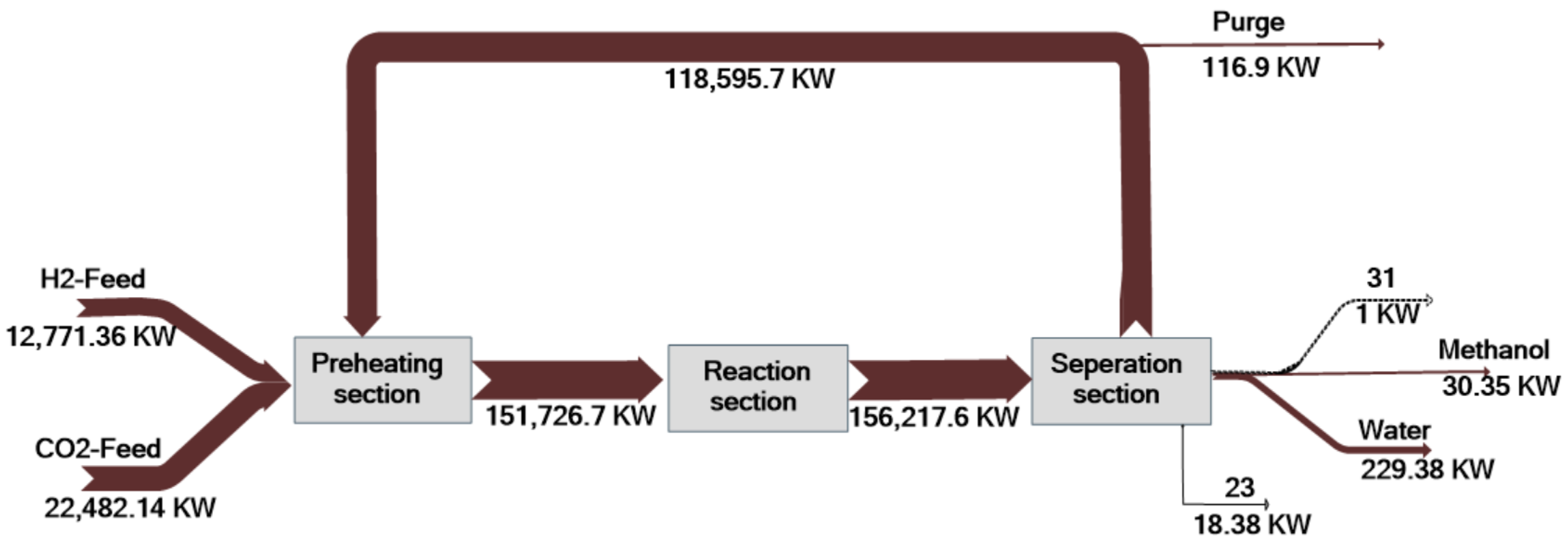Exergy Analysis of Methanol Production Plant from Hydrogenation of Carbon Dioxide †
Abstract
:1. Introduction
2. Materials and Methods
2.1. Process Description
2.2. Exergy Analysis Equations and Formulations
3. Results and Discussion
4. Conclusions
Author Contributions
Funding
Institutional Review Board Statement
Informed Consent Statement
Data Availability Statement
Conflicts of Interest
References
- Chen, J.M. Carbon neutrality: Toward a sustainable future. Innovation 2021, 2, 100127. [Google Scholar] [CrossRef] [PubMed]
- Lane, J.; Greig, C.; Garnett, A. Uncertain storage prospects create a conundrum for carbon capture and storage ambitions. Nat. Clim. Change 2021, 11, 925–936. [Google Scholar] [CrossRef]
- González-Garay, M.; Frei, S.; Al-Qahtani, A.; Mondelli, C.; Guillén-Gosálbez, G.; Pérez-Ramírez, J. Plant-to-planet analysis of CO2-based methanol processes. Energy Environ. Sci. 2019, 12, 3425–3436. [Google Scholar] [CrossRef]
- Aghbashlo, M.; Tabatabaei, M.; Karimi, K. Exergy-based sustainability assessment of ethanol production via Mucor indicus from fructose, glucose, sucrose, and molasses. Energy 2016, 98, 240–252. [Google Scholar] [CrossRef]
- Atmaca, A.; Yumrutaş, R. Thermodynamic and exergoeconomic analysis of a cement plant: Part II–Application. Energy Convers. Manag. 2014, 79, 799–808. [Google Scholar] [CrossRef]
- Kamate, S.C.; Gangavati, P.B. Exergy analysis of cogeneration power plants in sugar industries. Appl. Therm. Eng. 2009, 29, 1187–1194. [Google Scholar] [CrossRef]
- Assari, M.R.; Basirat, T.H.; Najafpour, E.; Ahmadi, A.; Jafari, I. Exergy modeling and performance evaluation of pulp and paper production process of bagasse, a case study. Therm. Sci. 2014, 18, 1399–1412. [Google Scholar] [CrossRef]
- Costa, M.M.; Schaeffer, R.; Worrell, E. Exergy accounting of energy and materials flows in steel production systems. Energy 2001, 26, 363–384. [Google Scholar] [CrossRef]
- Akram, U.; Ahmad, I.; Chughtai, A.; Kano, M. Exergy analysis and optimisation of naphtha reforming process with uncertainty. Int. J. Exergy 2018, 26, 247–262. [Google Scholar] [CrossRef]
- Samad, A.; Saghir, H.; Ahmad, I.; Ahmad, F.; Caliskan, H. Thermodynamic analysis of cumene production plant for identification of energy recovery potentials. Energy 2023, 270, 126840. [Google Scholar] [CrossRef]
- Dowlati, M.; Aghbashlo, M.; Soufiyan, M.M. Exergetic performance analysis of an ice-cream manufacturing plant: A comprehensive survey. Energy 2017, 123, 445–459. [Google Scholar] [CrossRef]
- Yang, Q.; Zhang, Z.; Fan, Y.; Chu, G.; Zhang, D.; Yu, J. Advanced exergy analysis and optimization of a CO2 to methanol process based on rigorous modeling and simulation. Fuel 2022, 325, 124944. [Google Scholar] [CrossRef]
- Van-Dal, É.S.; Bouallou, C. Design and simulation of a methanol production plant from CO2 hydrogenation. J. Clean. Prod. 2013, 57, 38–45. [Google Scholar] [CrossRef]
- Szargut, J.; Morris, D.R.; Steward, F.R. Exergy Analysis of Thermal, Chemical, and Metallurgical Processes; Springer: Berlin/Heidelberg, Germany, 1988. [Google Scholar]
- Samad, A.; Ahmad, I.; Kano, M.; Caliskan, H. Prediction and optimization of exergetic efficiency of reactive units of a petroleum refinery under uncertainty through artificial neural network-based surrogate modeling. Process Saf. Environ. Prot. 2023, 177, 1403–1414. [Google Scholar] [CrossRef]


| Formulas for Exergy Analysis and Its Performance Indicators | |
|---|---|
| Physical exergy at standard conditions | |
| Irreversibility calculates the difference between exergy input and output in a process or system | |
| Exergy efficiency measures how closely a system approaches ideal performance as a percentage | |
| Exergetic improvement potential calculates the reduction in irreversibility achievable within a process | |
| Equipment | Exergy Destruction (KW) | Exergy Efficiency (%) | Improvement Potential (KW) | Equipment | Exergy Destruction (KW) | Exergy Efficiency (%) | Improvement Potential (KW) |
|---|---|---|---|---|---|---|---|
| R-1* | −4490.86600 | 102.96 | 132.92236 | CP-1 | 457.97617 | 78.44 | 98.71681 |
| DIV-1 | 0.00000 | 100.00 | 0.00000 | HX-4 | 53,771.94971 | 71.86 | 15,130.63269 |
| KO-1 | 0.00000 | 100.00 | 0.00000 | DT-1 | 744.69335 | 70.86 | 217.00320 |
| MIX-1 | 64.17148 | 99.72 | 0.17822 | VLV-1 | 319.34698 | 44.47 | 177.33476 |
| CP-6 | 650.55879 | 99.45 | 3.54918 | VLV-2 | 231.36874 | 9.53 | 209.32192 |
| HX-6 | 782.22825 | 99.35 | 5.07421 | HX-7 | 12,029.94934 | 0.25 | 11,999.66660 |
Disclaimer/Publisher’s Note: The statements, opinions and data contained in all publications are solely those of the individual author(s) and contributor(s) and not of MDPI and/or the editor(s). MDPI and/or the editor(s) disclaim responsibility for any injury to people or property resulting from any ideas, methods, instructions or products referred to in the content. |
© 2024 by the authors. Licensee MDPI, Basel, Switzerland. This article is an open access article distributed under the terms and conditions of the Creative Commons Attribution (CC BY) license (https://creativecommons.org/licenses/by/4.0/).
Share and Cite
Zulkefal, M.; Ayub, A.; Sethi, H. Exergy Analysis of Methanol Production Plant from Hydrogenation of Carbon Dioxide. Mater. Proc. 2024, 17, 15. https://doi.org/10.3390/materproc2024017015
Zulkefal M, Ayub A, Sethi H. Exergy Analysis of Methanol Production Plant from Hydrogenation of Carbon Dioxide. Materials Proceedings. 2024; 17(1):15. https://doi.org/10.3390/materproc2024017015
Chicago/Turabian StyleZulkefal, Muhammad, Asad Ayub, and Hamza Sethi. 2024. "Exergy Analysis of Methanol Production Plant from Hydrogenation of Carbon Dioxide" Materials Proceedings 17, no. 1: 15. https://doi.org/10.3390/materproc2024017015







